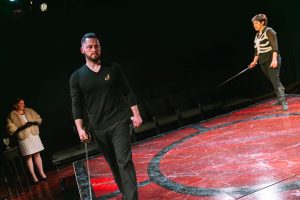By Rikki Lee Travolta
Red Theater takes on the challenge of “Hamlet” – one of William Shakespeare’s most well-known works – under the watch of Jeff-nominated director Wyatt Kent at The Edge Off Broadway in Chicago’s Edgewater neighborhood.
Rather than go big, Kent invites the audience in for an up-close experience. The payoff is a smartly directed creation that sizzles with emotion.

“Hamlet”, as written, can span up to or even over four hours.
The King of Denmark has been murdered by his brother Claudius. His widow quickly marries the brother who becomes the new king; the two having been engaged in an affair. Haunted by the loss of his father, Hamlet feigns madness in a bloody plot to take revenge.
Is that the full story? Not at all.
However, “Hamlet” is rarely performed in its entirety. It is in most instances abridged in some fashion to a less epic undertaking. And, depending on who does the cutting – different parts of the remaining story tend to get downplayed or eliminated.
There are different theories on the length at which it was performed in Shakespeare’s day.
There is text that leads some to believe performances at The Old Globe, where Shakespeare’s plays were most famously staged, were limited to two hours in length.
If this was the case, then Shakespeare’s company, the King’s Men, would have been performing a version featuring Richard Burbage as the Danish Prince roughly half what the full text now represents.
Some argue that there was no such two-hour limit at The Old Globe or that such rules were not generally enforced. Still, that does not necessarily mean it was initially performed at the four-hour length.
Many of Shakespeare’s plays had never been published in written form at the time of his death. Seven years after his passing, John Heminge and Henry Condell of his troupe the King’s Men published his plays in what is now called the First Folio.
These scripts were based on various sources – ranging from widely varying variations of scripts tracked from various productions to even just an individual’s memory. As such, one theory put forth is that the four-hour version that was published was inclusive of text from multiple different renditions to paint a complete vision of Shakespeare’s intent.

There are those who argue that theatre audiences in Shakespeare’s day were a different sort than that of today. With the often bawdy humor injected into his plays emphasized and a stadium-like crowd atmosphere, theatergoers could happily be entertained for such an extended time. It carried the excitement equivalent of a modern-day NFL game.
Kenneth Branagh, arguably the greatest cinematic interpreter of Shakespeare’s works, adapted, directed, and starred in a sweeping movie version of “Hamlet” that included every word of the full text of the play. The unabridged film released in 1996 runs 242 minutes, or four hours and two minutes.
But while widely regarded as the best film adaptation of “Hamlet”, with some labeling it a masterpiece, the film was a box office flop. The general public doesn’t seem to get excited about that much of a commitment.
Recognizing this, Red Theater has cut its production down to a run time of around three hours including an intermission that Is appropriately placed from both a time and plot standpoint.
In the intimate Edge Off Broadway space, director Kent has done away with the embellishments of set pieces much beyond an occasional chair. Props, too, are minimal.
This “Hamlet” is a bare-bone production that puts the focus on the acting. That can be a gamble.
If you put a mediocre performer in a great costume with thrilling backup dancers behind them, at least there’s something to distract the senses.
If you are going to put actors on a barebones stage, in an intimate space where the audience is just a few feet away – they had better be darn good.
Ashley Fox, who plays Hamlet, is onstage in character from the time the audience is admitted into the black box space. The raised square playing area is at the center of the room, with seating on all four sides.
Hamlet, a young man of around 30, sits looking through a photo album. He is a forlorn figure. Yet there is an intensity to how he studies the pictures.
As the final patrons take their seats and the lights adjust to indicate the start of the performance, tears begin to trickle down Fox’s face as Hamlet rips a photo from the book and runs from the stage.
To be able to time the tears of one’s performance that precisely is an incredible skill. That level of talent shown in that moment exemplifies the depth of skill of Fox as an actor.
Delightfully, the cast as a whole is wonderfully talented. Some, like Fox, shine with a special intensity.

Julia Rowley brings a playful, gawkiness and silliness to the role of Ophelia that is a breath of fresh air. It also masterfully allows her to show her complete development of the character with contrasting aspects of her personality.
At times Rowley’s Ophelia is sly, at other times strong and determined. Other times she shows a girl smitten, a sister concerned, a daughter that is obedient to a point, and a woman who can show anger when crossed.
When Hamlet both rejects her affections and then inflicts an ultimate tragedy upon her family, Ophelia descends into madness. This is a trapeze upon which a great artist can put their full genius on display. Rowley dazzles.
The villain of the tragedy, Claudius, is a meaty role. It offers the actor the opportunity to explore many, many levels and facets. There are also enough chestnut moments in the script to give the opportunity to truly demonstrate one’s gusto and command of the space.
Robert Koon tackles the sheer daunting scope of the text with attention to every word. He works the in-the-round space with practiced skill. It is a solid performance that shows his dedication to his craft. I appreciated his ability to find the humor lines without losing any of the authenticity of the character.
Hamlet’s mother Gertrude brazenly weds her dead husband’s brother within months of what is of course a murder disguised as suicide. Kelly Levander does a very nice job jumping through all the various emotional hoops.
Levander shows an evilness of someone who could be involved in such nastiness, but still is also authentic in a way that shows she truly loves her son. And she demonstrates complete devastation when Hamlet finally forces her to look in the mirror.

Zach Bloomfield is a real standout in the role of Polonius. He is the father of Ophelia and Laertes. He is also an opportunistic member of the government.
Bloomfield is marvelously evil, with his lips as attached to Claudius’ backside as Ted Cruz’s are to Donald Trump’s. But he also shows a loving quality with his children. It is a well-rounded performance.
Some of the most outstanding moments in this production of “Hamlet” come from the comic characters. As a director, Kent is wise to accentuate these characters. Shakespeare’s tragedies involve a lot of death; the insertion of occasional humor makes these titles a more palatable meal to enjoy.
In the first act, Rosencrantz and Guildenstern provide the designated comic relief. Hilariously brought to life by Harrison Lampert and Mary Townsend Cahoon, they get funnier and funnier with every opportunity.
In the second act, Josh Razavi’s Gravedigger is a hoot and a half. Although not the focus of the show, it is one of the most enjoyable performances in the production. Sometimes little gem performances like that just jump out.
Ian Maryfield puts in a strong showing as Laertes. The duals with Hamlet demonstrate skilled swordsmanship by both Maryfield and Fox. Reginald Hemphill makes a passionate Horatio.
The cast also includes Tatiana Pavela and Tusli McDaniels, who are effective in multiple roles. Understudies include Tess Gabiati, Craig Duff, Aimee Kleiman, RJ Cecott, and Matty Schnitker.

Keeping with the bare-bones motif, costumes aren’t a primary focus. Designed by Madeline Felauer, they are modernesque without being time-specific.
Hamlet and Horatio are in jeans. Claudius is in a suit. There are swords where appropriate. But for the most part, the costumes seem to suggest a nonspecific theme or time.
Sound design is very well done with the tools available. Sebby Woldt impresses in this capacity – which is often hard to do in any storefront space.
Technical direction and props design are by Andy Cahoon, scenic design is by Rose Johnson, lighting design is by Derryll, fight and intimacy design is by Jamie Macpherson, casting director is Becca Holloway, and text coach is Meredith Ernst. Music is by Dr. Lexi Signor.
The production is produced by the company’s co-artistic director Clare Brennan. Stage manager is Tessa Huber, assistant director is Sean William Kelly, Junipero “Juni” Cruz is the assistant stage manager, and Ian Maryfield is the fight captain.
“Hamlet” is a rich and intricate text in which one can find new things each and every time it is explored. A lot of thought and talent has been poured into Red Theater’s production. Featuring some very gifted performers, it is well worth the experience.
“Hamlet” plays through May 19th with performances on Thursdays through Saturdays at 7:30 PM, Sundays at 3 PM, and Mondays at 7:30 PM, with a special Wednesday 5/15 performance at 7:30 PM.
The Edge Off Broadway is located at 1133 W. Catalpa Avenue in the Edgewater neighborhood of Chicago.
Tickets are available at www.RedTheater.org
Photo Credit: Wannabe Studio
For more reviews visit: Theatre in Chicago – your source for What’s on Stage in the Chicago Area.





